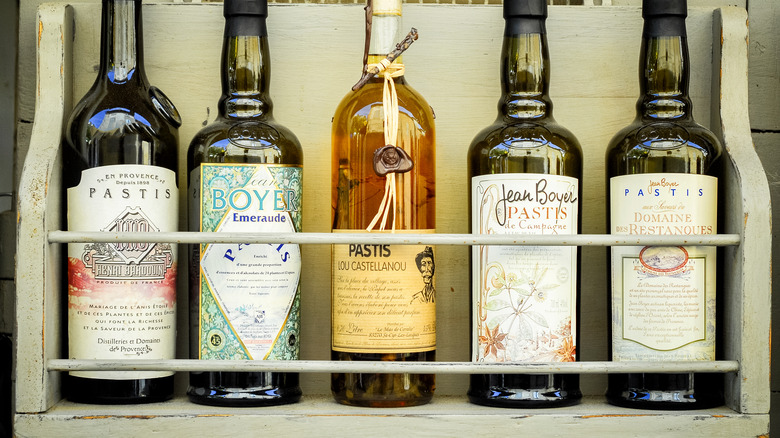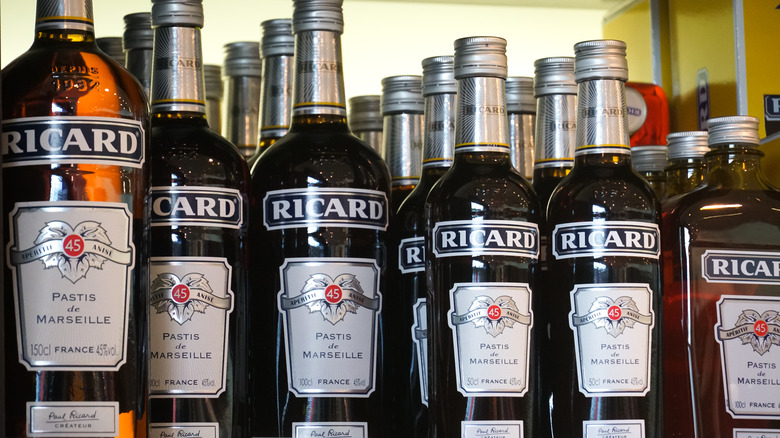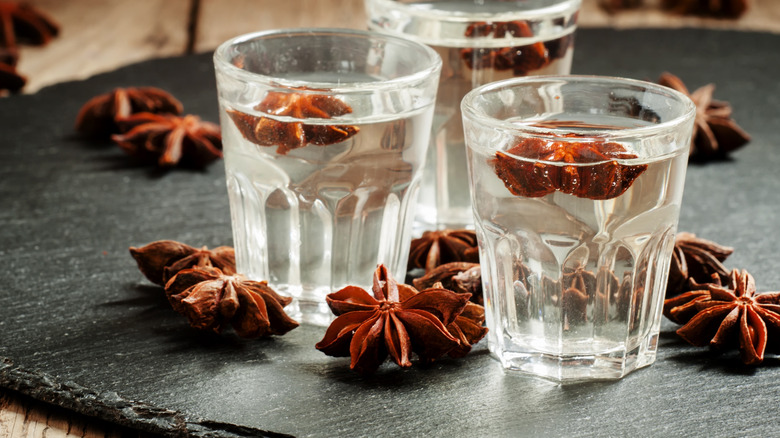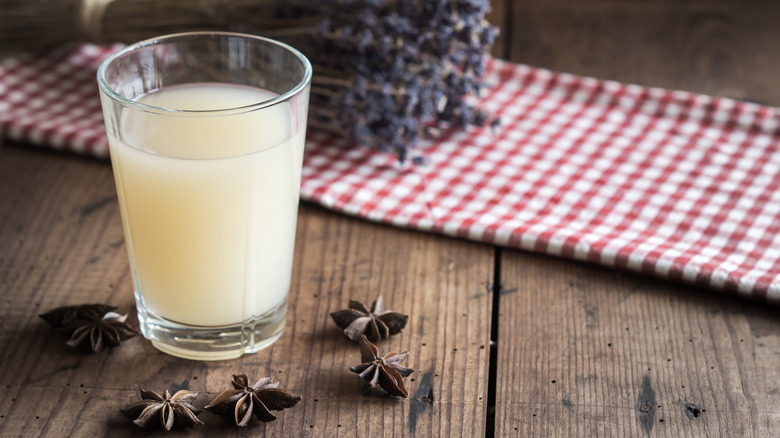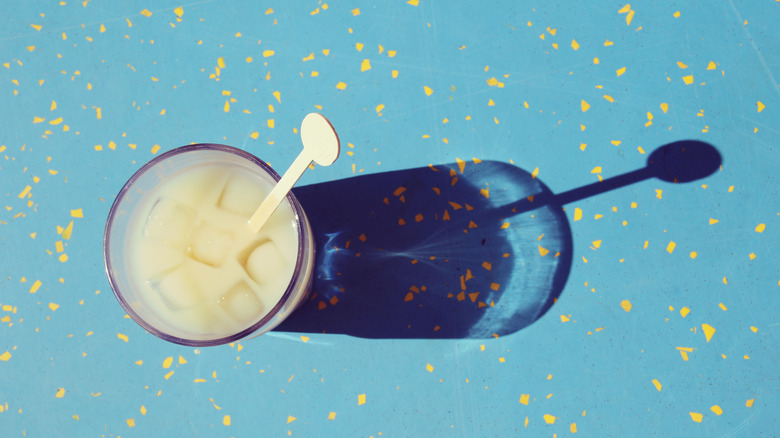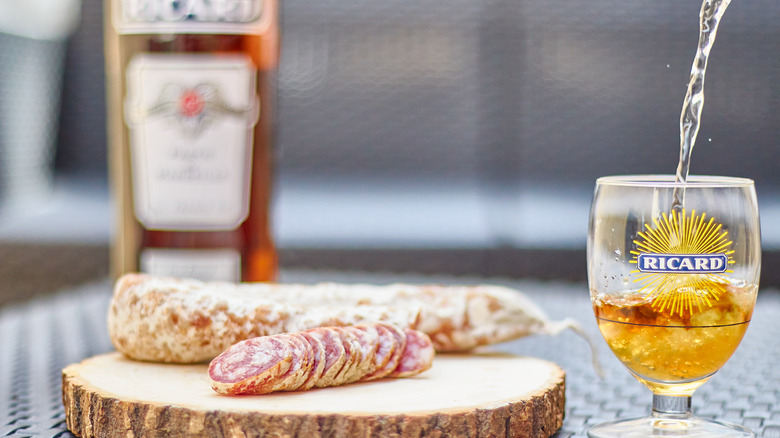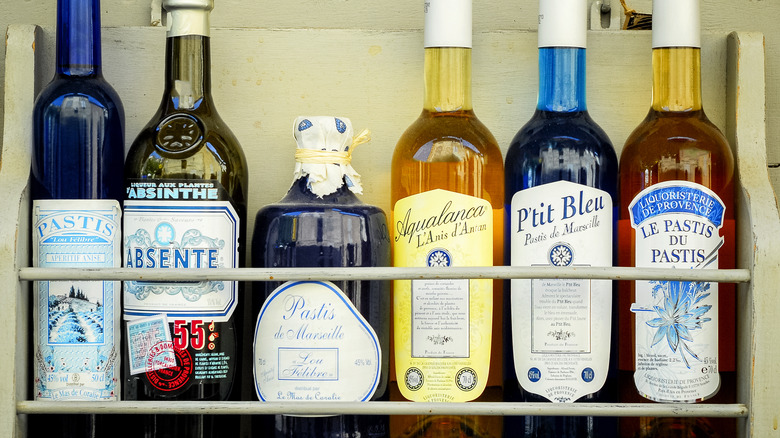Pastis: The French Aperitif You Should Try
Early in the 20th century, the French had a taste for a potent anise and wormwood-infused elixir called absinthe. The frenzy-inducing high-proof liqueur, popular with literati, artists, and celebrities of the day, was believed to cause hallucinations, disgraceful behavior, and the general decline of the moral fiber of the nation. A casualty of a sweeping global temperance movement, absinthe was banned in France in 1915, per BBC. In fact, France banned all spirits above 16 proof or eight percent alcohol by volume. Realizing his countrymen still craved the pungent botanical spirit, Paul Ricard developed an aniseed and liquorice liqueur, leaving out wormwood and lowering the proof. Ricard released his blended spirit under the name pastis, derived from the Occitan word pastisson (mixture), in his hometown of Marseille, France, per The Good Life France. Pastis was an instant hit and quickly became a mainstay beverage along the southern coast of France.
Ricard's liquorice and anise-flavored pastis soon carried his name to differentiate itself from an influx of imitators. Brands like Pernod, released in 1938, created a drier style with heady aromatics derived from a spectrum of herbs and spices, per Punch Drink. In a case of joining them rather than beating them, Pernod and Ricard partnered in 1975, under the moniker, Pernod Ricard. Hardly the only two producers of pastis, Pernod and Ricard are the most famous.
What is pastis?
In the days before the rise of western medicine, people relied on botanicals to treat what ailed them. Herbs and plants were the foundations of medicine. Tales of the Cocktail indicates that as early as the 1300s, monks, scientists, and physicians concocted healthy herbal elixirs by macerating medicinal herbs in alcohol as a preservative. These creations, used as cure-alls, particularly for digestive ailments (Liquor.com), are the precursors to the bitters and liqueurs we have today. Liqueur brands like Chartreuse, Drambuie, and Amaro, still adhere to the life-enhancing herbal liqueur lore of days long past.
Pastis is an herbal liqueur crafted from star anise or anise seed, liquorice root, sugar, and a 40 to 45-percent alcohol by volume neutral base liquor, according to the Pastis de l'Ile de Ré brand website. As just one of at least 80 types of herbal liqueurs, Taste Atlas reveals that the actual recipe for pastis is a stealth combination of star anise, cardamom, sweet melissa, cinnamon, peppercorn, sage, fennel, and lemon verbena.
Each producer has its own well-kept secret recipe; some expand the range of botanicals used and others reduce or augment the sugar levels.
Originally, herbal liqueurs were crafted using fresh and dried herbs, roots, seeds, bark, and other botanicals. These days, many herbal liqueurs, including some pastis, are produced by blending neutral base alcohol like vodka or brandy with plant distillates or essences and natural or artificial colors. This step allows for consistent, large-scale production, per The Good Life France.
What does pastis taste like?
Given its list of ingredients, pastis tastes most like freshly crushed anise seed, which has a woodsy, sharp, warm, slightly sweet, and spicy, aroma and flavor. MasterClass reveals that star anise and anise seed are two different plants with similar flavors. Anise seed (Pimpinella anisum) is an ancient plant from the eastern Mediterranean region. First cultivated in Egypt, it is part of the parsley family of herbs. Anise seeds lend their fragrant flavor to pizzelle cookies, candy, confections, and savory foods like Italian sausage. Its signature flavor, similar to tarragon, liquorice, and fennel, comes from the anethole oil present in its foliage and seeds. This compound turns pastis from clear yellow to opaque white upon mixing it with water.
Star anise, on the other hand, is the whole dried seed pod of the Chinese Star Anise evergreen tree (Illicium verum). Star anise also contains anethole oil, giving it a robust, bitter, strong black liquorice flavor. One of the essential ingredients in Chinese five spice and garam masala, when pulverized, it is often found in savory Asian and Indian cuisine, per sources. These days, anise seed and star anise can be used to produce pastis.
Pastis as an apéritif
Advanced Mixology suggests that an aperitif is a tasty, pre-meal libation, aimed at stimulating the appetite. Characteristically, aperitifs are lowish in alcohol, coming in below 25 percent alcohol by volume. They tend to be dry, herbal, bitter, light, and crisp. Bitter herbs are known to stimulate the appetite. Most often, aperitifs are served blended, cold, and in small quantities. Pungent anise-flavored liqueurs like pastis are perfect aperitifs.
The Good Life France reports that while Pastis can be drunk straight, it is best diluted with water. In France, pastis is served in its pure state along with a carafe of water allowing for a personalized ratio every time. Generally, Pastis is diluted; one part liqueur to four to seven parts chilled water To prevent over-dilution, ice has only added one cube at a time, after the liqueur is blended with water. Pastis is to be sipped slowly and an endeavor of one cocktail can take the better part of an afternoon.
Pastis cocktails
Pastis gives a lively and fresh quality to cocktails. Its bold and unique flavor shines when a drop or two is blended with champagne for a Death in the Afternoon cocktail, per The Good Life France. Add a splash of pastis to sparkling water, soda, or tonic. Remember, a little aromatic pastis goes a long way. Bespoke Unit suggests that pastis is featured in many classic and craft cocktails including the Marseille Mule, Pastis Old Fashioned, the Mediterranean, and the Niçois Cocktail.
Try the Pastisito, a blend of pastis, rum, mint, and simple syrup is an herbal upgrade to the basic mojito. The Pastis Sazerac is a simple blend of pastis, cognac, and bitters, with a lemon peel garnish. By marrying ginger beer and anise liqueur, the Mediterranean Mule brings the heat up a notch on the Moscow version. Craft a Momisette with pastis, orgeat (orange blossom water and almond syrup) and a generous pour of sparkling water (Liquor.com) or a Le Perroquet, named after the kelly green feathers of a parrot; blend pastis, water, and just enough mint syrup to richly color the cocktail, per sources.
Punch reports that Pastis is a fantastic liqueur for blended cocktails and can jazz up your after-dinner cocktail. While not technically a digestif, which is served neat, the herbs in pastis, like most bitter liqueurs, are good for digestion.
What to eat with pastis
Anise-infused liqueurs are prevalent along the northern and eastern Mediterranean coastline from France to the Levant (Syria, Lebanon, and Israel), via "Essentials of Mediterranean Cooking" and Pastis is a perennial favorite. Aside from being a refreshing drink on sunny Provençal afternoons, Pastis is an essential ingredient in a lush bouillabaisse seafood stew, adding depth of flavor and a spicy tang to the classic French dish.
Stimulating for the appetite, serve pastis alongside nibbly bits like briny olives, crunchy crackers, roast almonds, and walnuts. Put together an ample charcuterie board with salty hard cheeses like pecorino romano and sheep manchego, prosciutto crudo, tangy capers, rich smoked fish, and fresh or pickled antipasto, for your next picnic on a sunny afternoon, and slip a bottle of pastis into your picnic basket. Find a shaded spot under a tree, enjoy a good book, and slowly devour your meal and cocktail. What a French way to spend a luxurious day.
More anise flavored liqueurs
Food & Wine reveals that there are many Pastis brands available in France but none compete with the recognition of the original Ricard and its dryer counterpart, Pernod. Pastis is just one of many anise-flavored liqueurs.
Liquor.com indicates that there are at least fifteen types of anise-flavored liqueurs, each with its individual style and flavor profile. Spanish Patxaran, Greek ouzo, Italian sambuca, Turkish raki, Middle Eastern arak, French Pernod, and Hungarian unicum veer on the bitter and bold side of the flavor and style profile. While French Ricard, Spanish Chinchón, Anisette, and Mexican Xtabentuún tend toward a sweeter, perfumed style, with Xtabentuún as sweet as candy.
There are dozens more herbal liqueurs available to try. Taste Atlas lists eighty types ranging from bracingly bitter to satisfyingly sweet. Whatever your pleasure, pastis is right in the middle.
